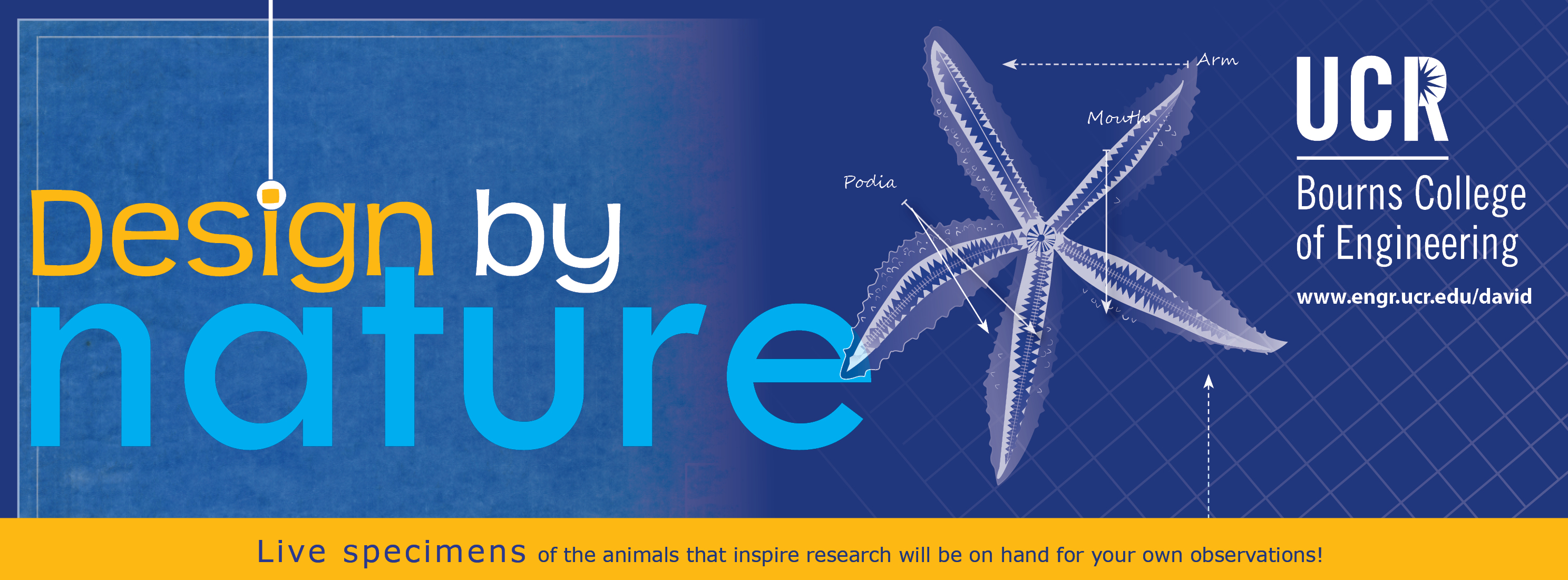Museum of Riverside

Design by Nature

Saturday, May 16, 2015 | 1 - 4 pm | Free
Join UC-Riverside Bourns College of Engineering Professor David Kisailus and his students as they share lessons learned from nature about the design of the next generation of engineering products.
Plants and animals always seem to construct the right
tools for survival, and they do it with environmentally friendly mechanisms and
materials. For example, Assistant Professor David Kisailus has studied the
chiton, a marine snail found off the coast of California. He is using the
snail's teeth to improve solar cells and lithium-ion batteries. Who would
have thought?!
Live specimens of the animals that inspire research at the College will be on
hand for your own observations!
All Ages Welcome. This a great opportunity for Middle
and High School students to learn more about science and science careers.
To learn more about UCR Bourns College of Engineering,
visit their website: http://www.engr.ucr.edu/
The research presented was funded by the
National Science Foundation, Air Force Office of Scientific Research, Army
Research Office and Winston Chung Global Energy.
BELOW IS A LIST OF LAST YEAR'S PROGRAM
1. Kisailus Biomimetic and
Nanostructured Materials Lab
Abstract:
Nature has evolved efficient strategies to synthesize materials that often
exhibit exceptional mechanical properties. This is because biological systems
can control the synthesis and hierarchical assembly of nano- to micro-scaled
building blocks. In the Kisailus Biomimetics and Nanostructured Materials Lab,
we are study these organisms to produce light-weight and tough biomimetic
composites for aerospace and automotive applications and nanostructured
materials for solar and battery applications.
2. What is a nanometer?
Abstract:
How small is “nano”? Imagine dividing the thickness of your hair 100,000 times.
That is approximately how small a nanometer is. Here, we give examples to show
how small this feature really is.
3. Using sunscreen for solar cell and water purification
Chris Yang, Wei Tan, Louis Lancaster, Wenting Hou, David Kisailus
Abstract:
Due to the rapidly growing industry, soaring oil prices and environmental
pollution are becoming huge concerns. Using processes inspired from biological
systems, we are taking materials found in sunscreen and shrinking them down to
the nanoscale to make the next generation of solar cells and photocatalytic
materials for water purification.
4. Shell-Inspired Li-ion Batteries
Ibrahim El-Haleed, Kuang Sheng, Kevin Yoo, Parawee Pumwongpitak, Jianxin Zhu,
David Kisailus
Abstract:
The clean energy offered by solar power is becoming a very attractive source to
replace fossil fuels due to its long-term benefits. However, the energy needs to
be stored in a battery so that it can be used during the night or on cloudy
days. Inspired by nature, we are making nanosized materials with unique shapes
and sizes for batteries that are environmentally friendly and highly efficient.
5. The Ultimate Predator! Making Body Armor from Shrimp?
Jeniene Abugherir, Nicholas Yaraghi, David Kisailus
Abstract:
The stomatopod is an aggressive marine crustacean that uses a set of hammer-like
appendages called dactyl clubs to smash through snail shells and other
mineralized prey with incredible force and speed. Here, we study the
structure-function relationships of this natural material and apply design
insights from nature towards the development of biomimetic engineering materials
that are tough, light-weight, and efficiently produced.
6. Shell-inspired Airplanes and Electric Vehicles?
Jessica Hernandez, Chris Salinas, David Kisailus
Abstract:
Through hundreds millions of years of evolution, snails have evolved hard and
light-weight shells, made of chalk, to defend against predators. We study the
nanostructured architecture of these shells to make light-weight and tougher
composites for aerospace and automotive structures.
7. Ocean Creature Uses Magnetic Teeth to Eat Islands
Olivia Daou, Evelyn Barajas Perez, Steven Herrera, David Kisailus
Abstract:
Chitons use 70 rows of magnetic teeth to chew through rock. This ocean dwelling
animal is about a foot long, looks like a cow tongue, and has given engineers
the blueprints for ultra hard, abrasion-resistant tunnel boring and machining
tools.
8. Revealing Mysteries from Fossils of an Ancient Sea
Ashlee Tyler, Mathew Knauss and Nigel Hughes
Abstract:
We’ve all heard the phrase “going round in circles” - well it’s been happening
for over 490 million years! UCR scientists are studying the circular tracks made
by ancient creatures at the bottom of the oceans that covered north America at
that time - when the shoreline was as far inland as Wisconsin! We’re still
trying to crack this half billion year old midwestern puzzle, but interesting
clues are emerging!
Stay Connected
Main Museum
|
Address: 3580 Mission Inn Avenue Riverside, CA 92501 Phone: (951) 826-5273 Hours |
|
| Closed for Innovation | |
Heritage House
|
Address: 8193 Magnolia Ave. Riverside, CA 92504 Hours Open Sept (1st weekend after labor day) to June. |
|
| Monday - Thursday | Closed |
| Friday - Sunday | Open at 12:00 pm - Last Tour at 3:15 pm |
| Closed Major Holidays | |
Harada House
| Not Open to the Public |


